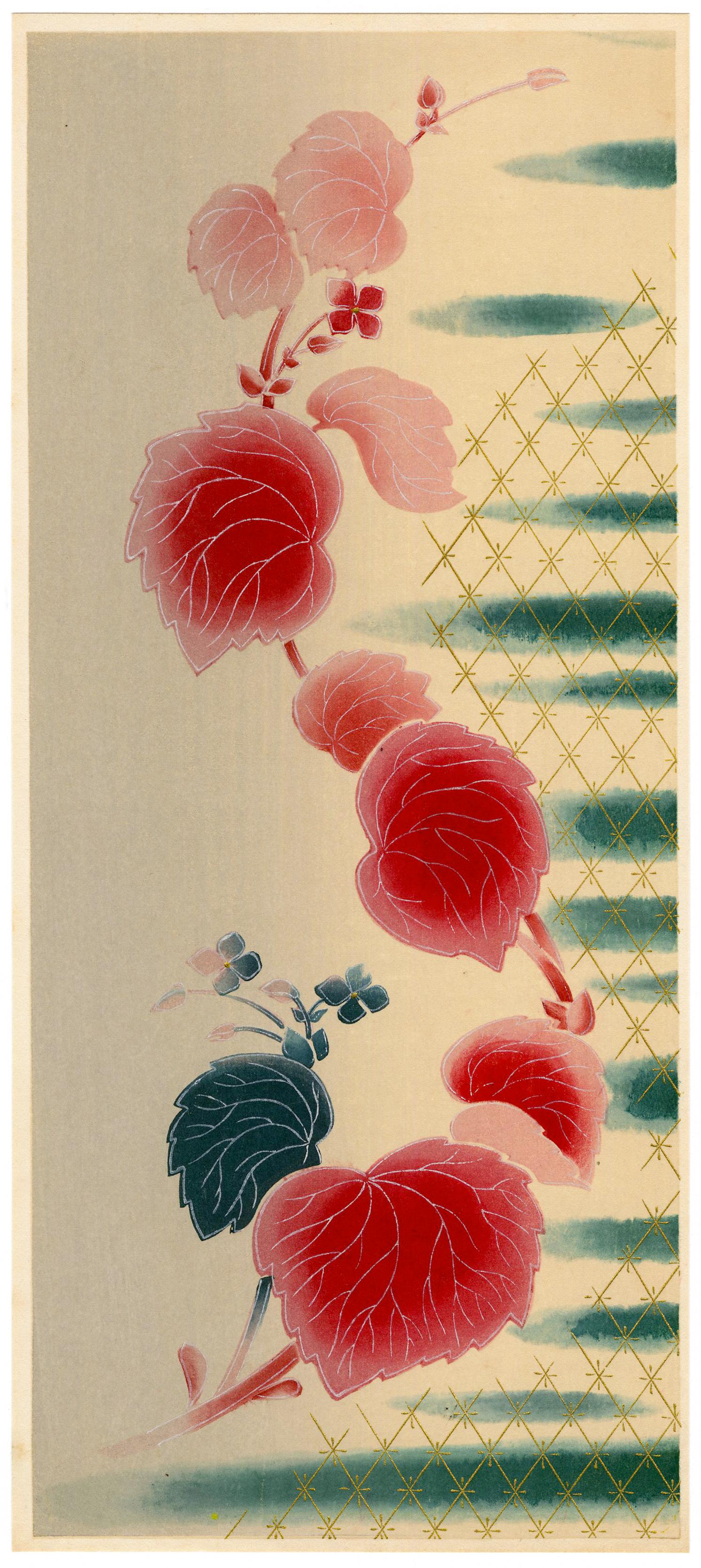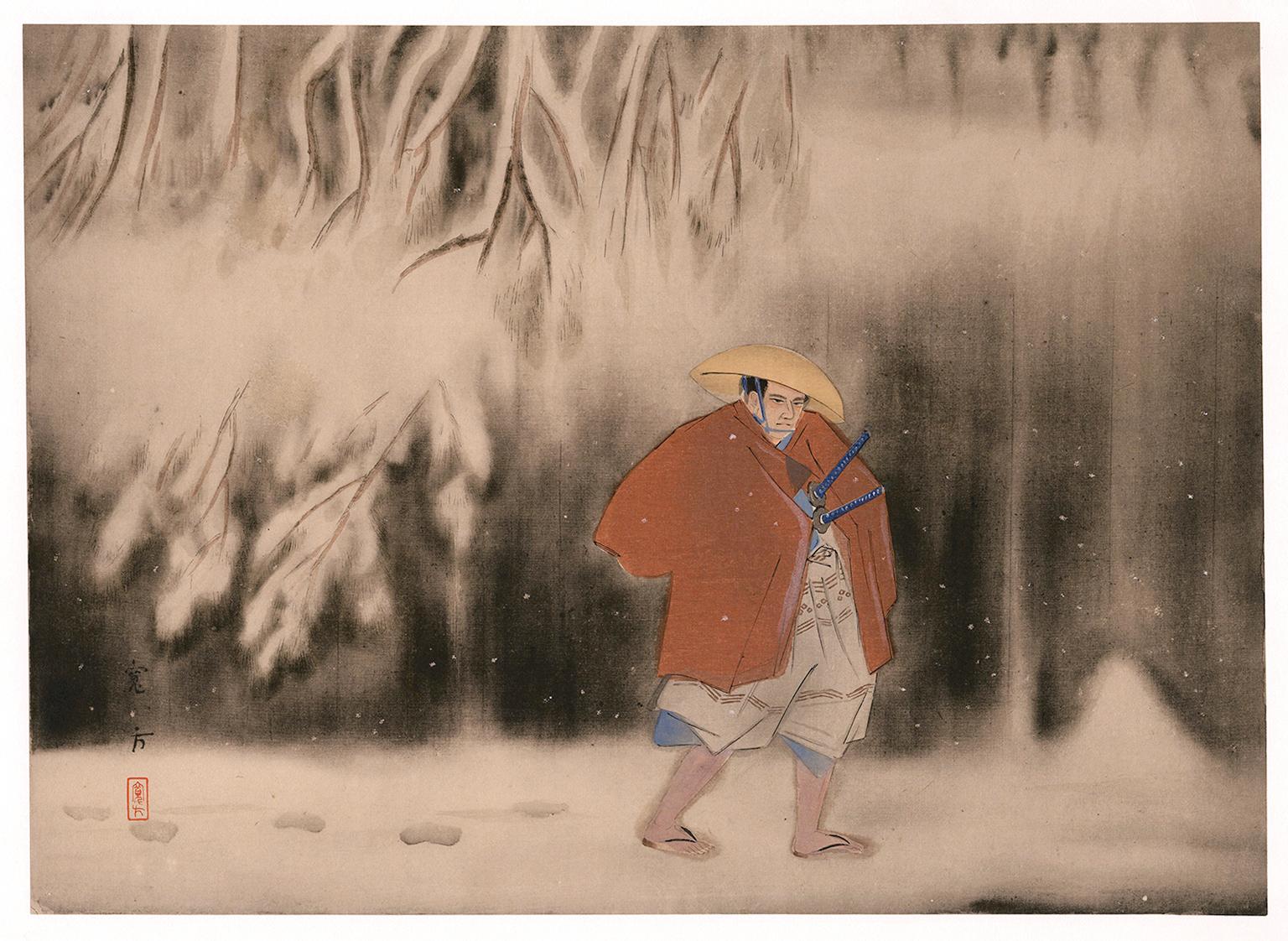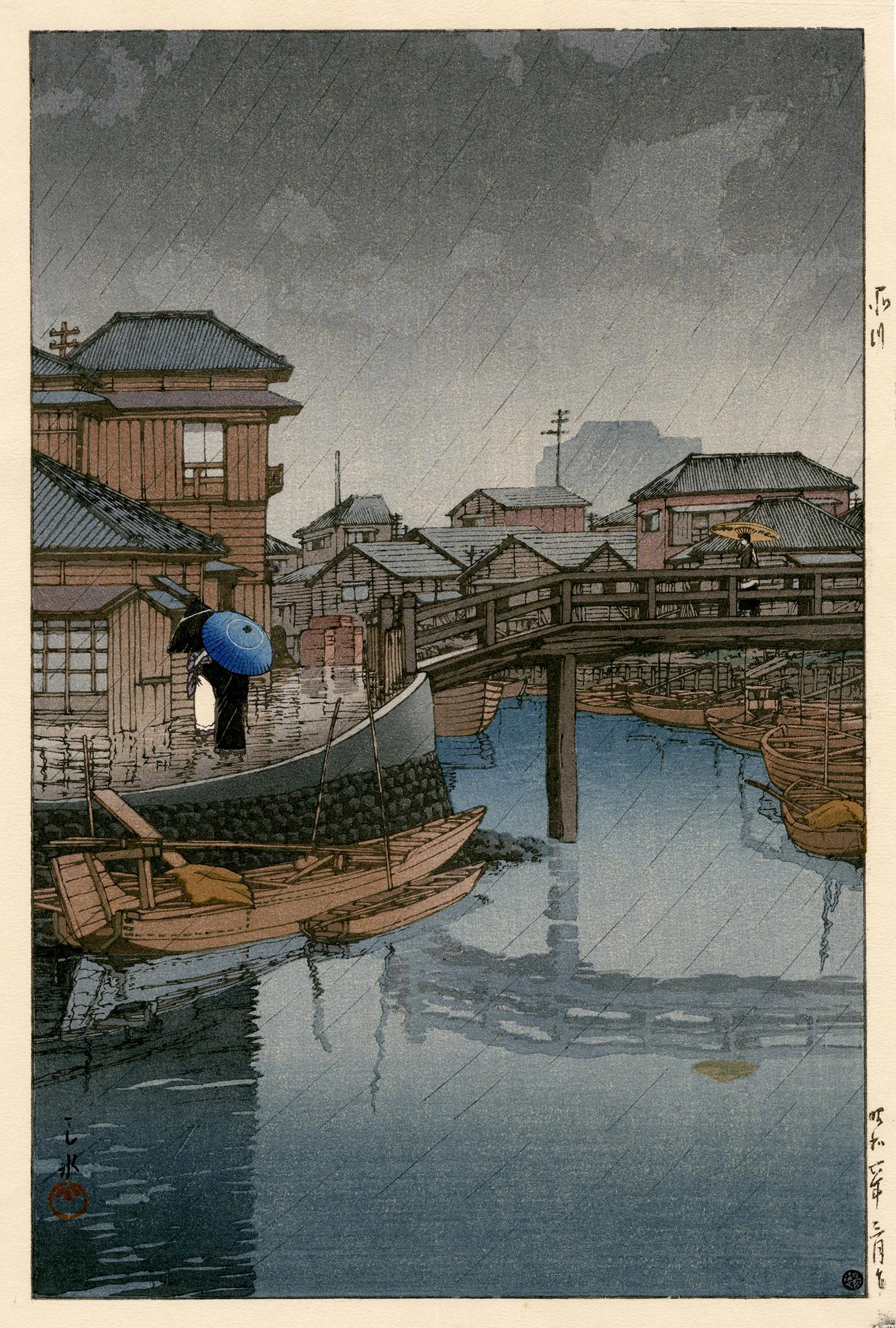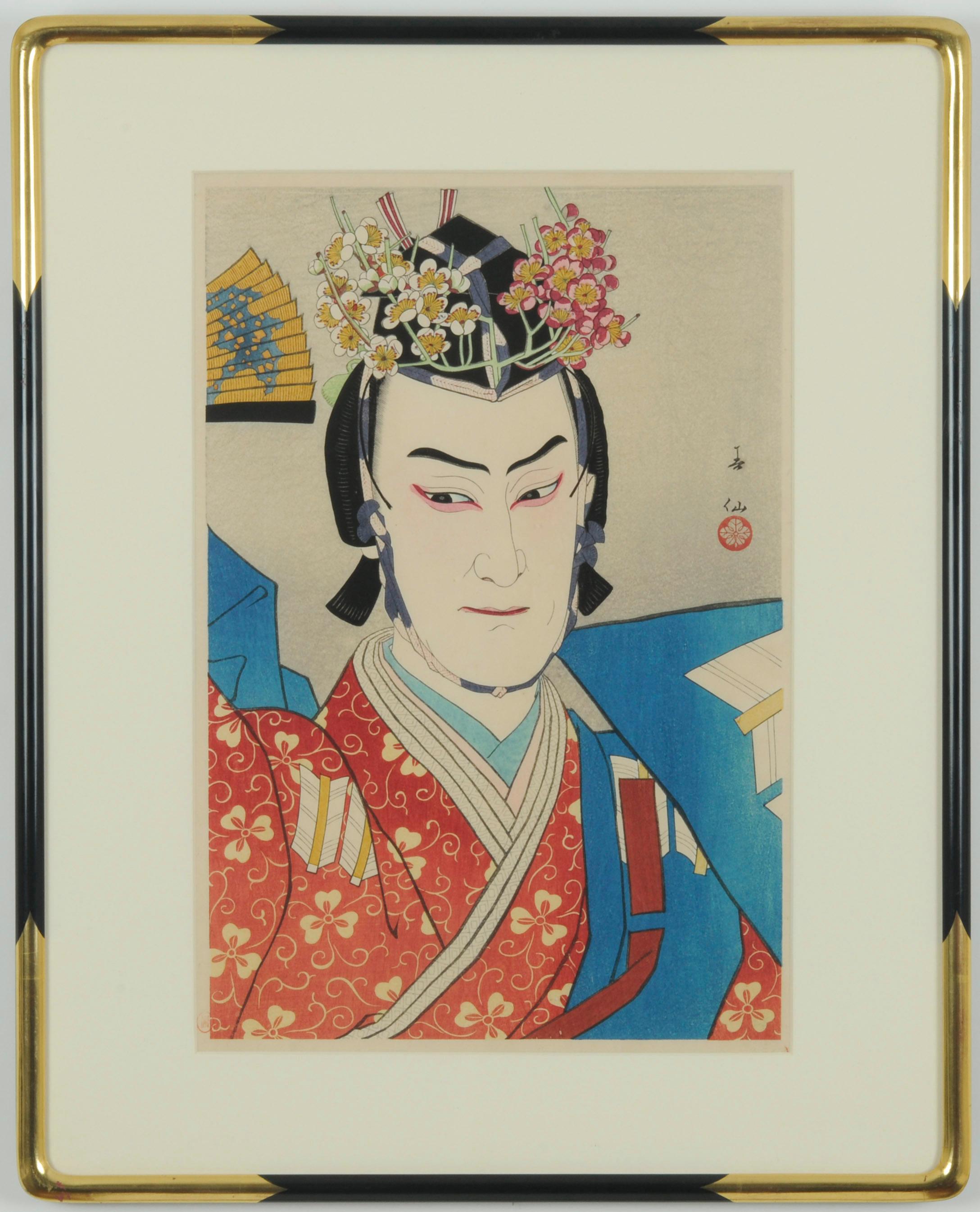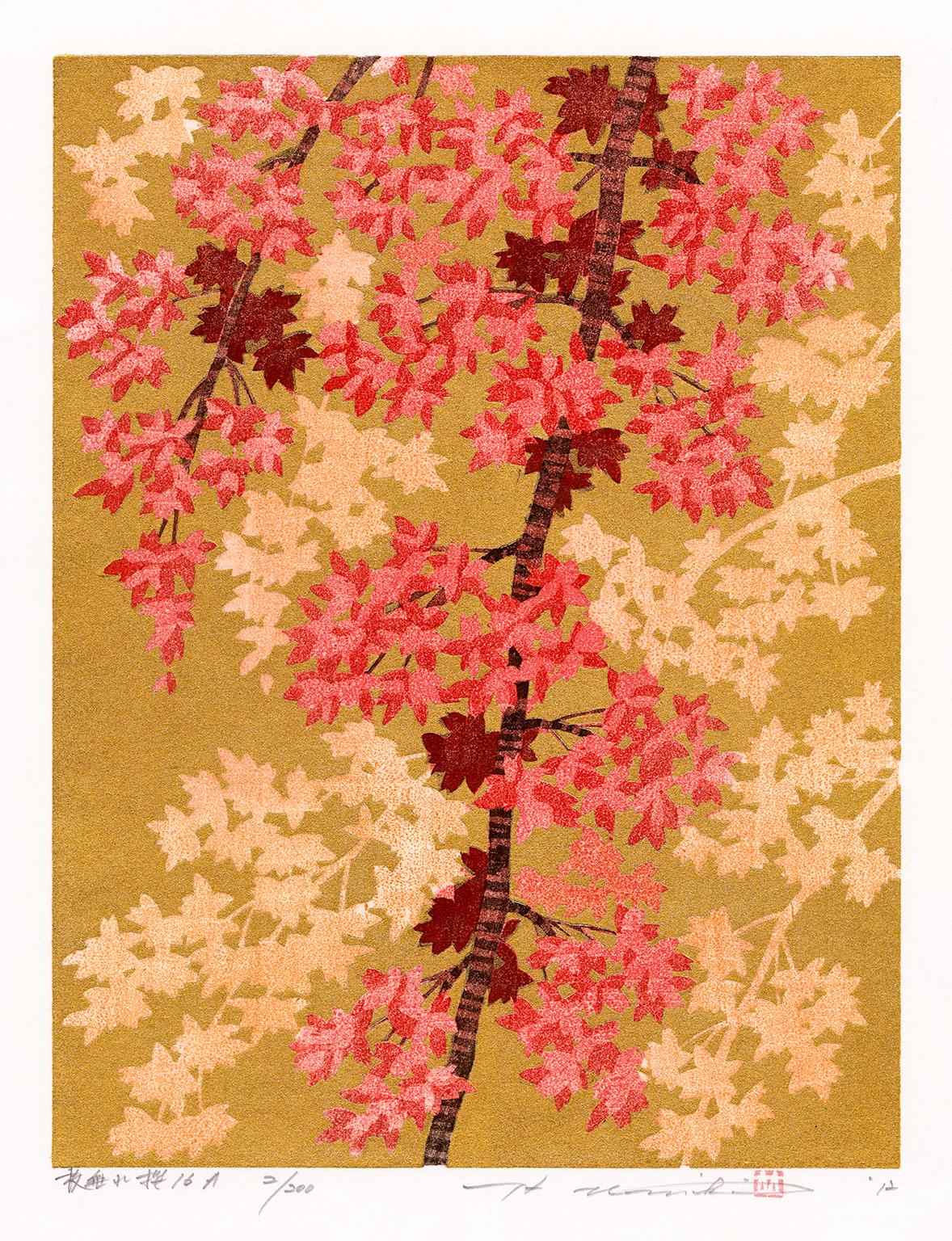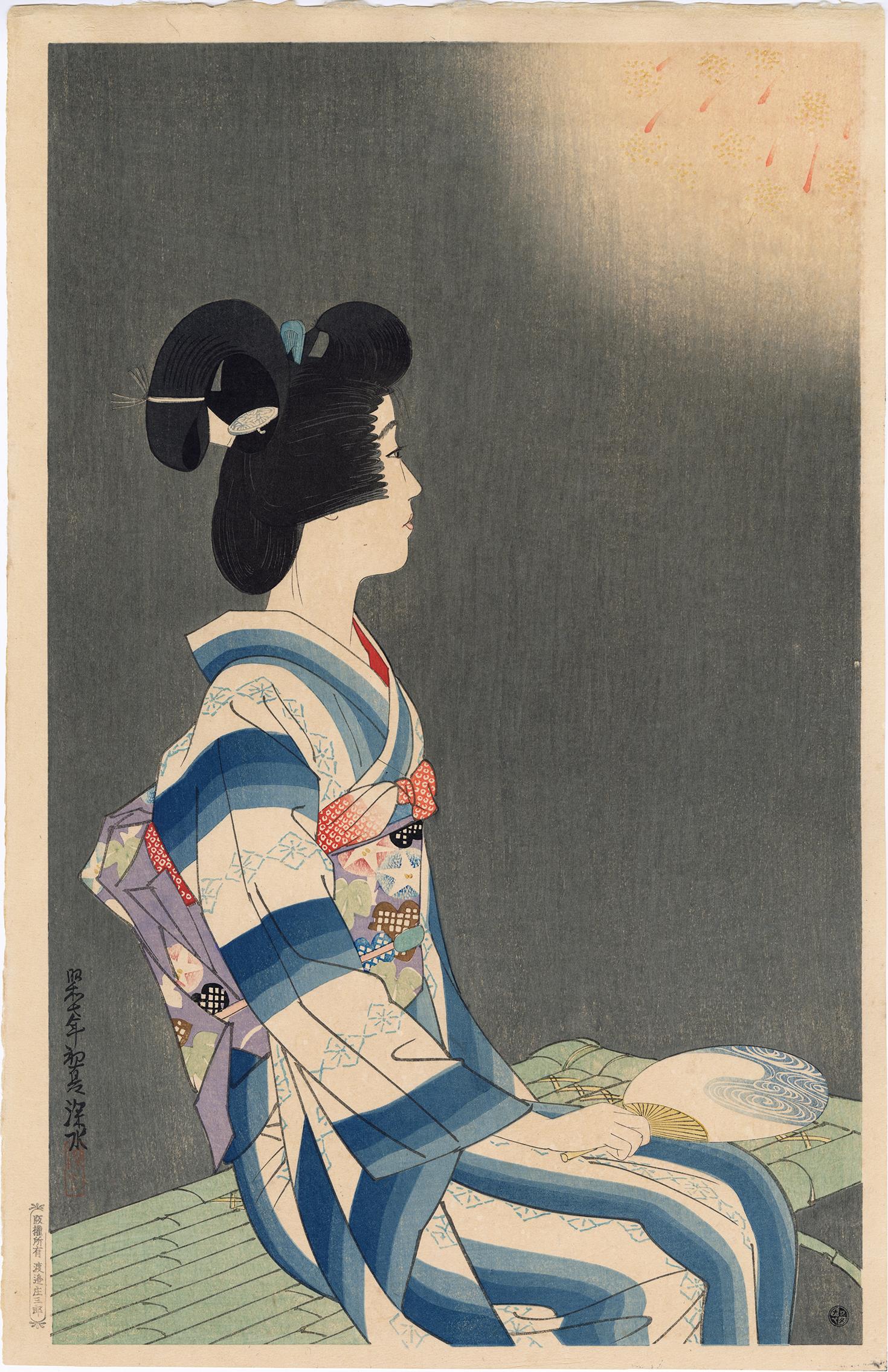Items Similar to Thirsty: The Appearance of a Town Geisha - a So-Called Wine-Server - in the Anse
Want more images or videos?
Request additional images or videos from the seller
1 of 7
Taiso YoshitoshiThirsty: The Appearance of a Town Geisha - a So-Called Wine-Server - in the Anse1888
1888
About the Item
Thirsty: The Appearance of a Town Geisha - a So-Called Wine-Server - in the Ansei Era
Color woodcut, 1888
Signed; Seal: Taiso (see photo)
Plate 22 from the series "Thirty-two Aspects of Customs and Manners" (Fuzoku Sanjuniso)
Format: Oban
Publisher: Tsunashima Kamekichi
Carver: Hori Yu
A first edition with tricolor cartouche, and black lacquer highlights
Yoshitoshi's "Thirty-two Aspects" depicts women of different social classes during the previous 100 years. The Ansei Era was 1854-1860.
Condition: Excellent
Image/Sheet size: 14 1/8 x 9 5/8 inches
Reference: Beauty and Violence 63.22
Stevenson, Yoshitoshi's Women, No. 22, pp. 72-73, reproduced in color
TAISO YOSHITOSHI
(1839-1892)
Taiso Yoshitoshi was born in the city of Edo (now Tokyo) just before Japan’s violent transformation from a medieval to a modern society. In the mid 19th century pressures from the United States and Europe brought an end to Japan’s two hundred years of self-imposed isolation. In 1868 a pivotal period began known as the Meiji Restoration. It was marked by the return of Imperial power, heightened militarism, a new constitution and industrial advancement, as well as social and political reform. In the midst of shifting values, woodblock print artists like Yoshitoshi struggled to create images that would satisfy the public’s changing tastes.
During the Edo period (1600-1868) woodblock prints, or Ukiyo-e (literally “pictures of the floating world”), became one of the most popular and inexpensive visual art forms in Japan. Published in the cities, visitors bought them as souvenirs and gifts from markets and street peddlers and returned with them to remote villages. From the time the first monochrome prints were published in the 1600s, Ukiyo-e represented a unique collaboration between the publisher, the artists and the public. The rising or diminishing interests of the urban merchant class largely dictated the choice of subject matter in woodblock prints.
Yoshitoshi’s confrontation with the savagery and violence of his times, especially early on in his career, was exorcised through a prolific and bloody series of prints depicting battling warriors, demons and murderers. Later in his career, however, Yoshitoshi’s work took on a distinctive stylistic change. By the 1880s, he was experimenting freely with western concepts of space, perspective and dissonant color combinations. His treatment of movement and facial features reflected a more studied and quiet observation of the human form and emotions. While continuing to choose native themes for his prints, Yoshitoshi’s approach to creating individualized portraits of townspeople, farmers, courtesans and warriors was innovative and groundbreaking. However, by the end of the Meiji Period (1868-1912), the increasing popularity of photography and lithography nearly eclipsed the public’s interest in woodblock prints. Yoshitoshi stood alone as the last great master of Ukiyo-e.
Biography courtesy International Folk Art
- Creator:Taiso Yoshitoshi (1839-1892, Japanese)
- Creation Year:1888
- Dimensions:Height: 14.13 in (35.9 cm)Width: 9.63 in (24.47 cm)
- Medium:
- Movement & Style:
- Period:
- Condition:
- Gallery Location:Fairlawn, OH
- Reference Number:
About the Seller
5.0
Recognized Seller
These prestigious sellers are industry leaders and represent the highest echelon for item quality and design.
Platinum Seller
These expertly vetted sellers are 1stDibs' most experienced sellers and are rated highest by our customers.
Established in 1978
1stDibs seller since 2013
716 sales on 1stDibs
Typical response time: 1 hour
Associations
International Fine Print Dealers Association
- ShippingRetrieving quote...Ships From: Fairlawn, OH
- Return PolicyA return for this item may be initiated within 10 days of delivery.
More From This SellerView All
- Morita Kanya XIII As Genta Kagesue in the play Genta KandoBy Natori ShunsenLocated in Fairlawn, OHMorita Kanya XIII As Genta Kagesue in the play Genta Kando Color woodcut, 1928 Signed and stamped middle right edge Natori stamp lower left image edge Series: Collection of Creative...Category
1920s Showa Figurative Prints
MaterialsWoodcut
- Lingering Snow Mount YoshinoBy Utagawa KuniyoshiLocated in Fairlawn, OHLingering Snow Mount Yoshino (Shidzuka-gozen toiling through snow after her last farewell to Yoshitsune) Signed: Ichiyusai Kuniyoshi ga Censor seal: Tanaka Series: Kenjo hakkei ...Category
1840s Figurative Prints
MaterialsWoodcut
- On the Beach at Long Branch - The Children's HourBy Winslow HomerLocated in Fairlawn, OHOn the Beach at Long Branch - The Children's Hour Wood engraving, 1874 Published in "Harper's Weekly" August 15, 1874 (p. 672) Image size: 9 1/4 x 13 5/8 inches Provenance: Wunderlic...Category
1870s Hudson River School Figurative Prints
MaterialsWoodcut
- Blossom Time in TokyoBy Helen HydeLocated in Fairlawn, OHSigned by the artist in pencil on the image Reference: Tim Mason and Lynn Mason, Helen Hyde (Washington, D.C.: Smithsonian Institution Press, 1991), 115, reproduced in color p. 68.Category
1910s Figurative Prints
MaterialsWoodcut
- Takeda Daizendayu Harunobu (Nyudo Shingen) Crouching in a FieldBy Taiso YoshitoshiLocated in Fairlawn, OHTakeda Daizendayu Harunobu (Nyudo Shingen) Crouching in a Field Color woodcut, 1878 Signed: Oju Yoshitoshi hitsu; Seal: Taiso (See photo) From the series: "A Mirror of Famous General...Category
1870s Other Art Style Figurative Prints
MaterialsWoodcut
- The Ghost of Seigen Haunting SakurahimeBy Taiso YoshitoshiLocated in Fairlawn, OHThe Ghost of Seigen Haunting Sakurahime Color woodcut, May 1889 Signed: Yoshitoshi; seal: taiso, lower right (see photo) Plate 5 from the series "New Forms of the Thirty-six Ghosts" Publisher: Sasaki A very fine lifetime impression of the second state (bi-colored cartouche) (see photo) The murdered lover of courtesan Sakurahime appears in the smoke from her brazier Format: Oban Condition: Excellent Image size: 14 3/8 x 9 3/4 inches Reference: Beauty and Violence, Plate 6 Stevenson, "Ghosts", Plate 5 TAISO YOSHITOSHI (1839-1892) Taiso Yoshitoshi was born in the city of Edo (now Tokyo) just before Japan’s violent transformation from a medieval to a modern society. In the mid 19th century pressures from the United States and Europe brought an end to Japan’s two hundred years of self-imposed isolation. In 1868 a pivotal period began known as the Meiji Restoration. It was marked by the return of Imperial power, heightened militarism, a new constitution and industrial advancement, as well as social and political reform. In the midst of shifting values, woodblock print artists like Yoshitoshi struggled to create images that would satisfy the public’s changing tastes. During the Edo period (1600-1868) woodblock prints...Category
1880s Other Art Style Figurative Prints
MaterialsWoodcut
You May Also Like
- Japanese Kimono Fabric Design — Color Woodblock Print, c. 1930Located in Myrtle Beach, SCAnonymous, Japanese Kimono Fabric Design, color woodcut, c. 1930. A superb impression, with fresh colors, fine graduations, and metallic gold motifs, on ...Category
Early 1900s Showa Figurative Prints
MaterialsWoodcut
- Samurai Walking in Snow — Forty-seven Ronin Memorial Series, 1920Located in Myrtle Beach, SCArai Kanpo, 'Samurai Walking in the Snow' from 'Gishi Taikan' (Pictures of Loyal Followers), Forty-Seven Ronin Memorial Series, color woodblock print, 1920. Signed Kanpo with the art...Category
1920s Showa Figurative Prints
MaterialsWoodcut
- 'Rain at Shinagawa, Ryoshimachi' — lifetime impressionBy Kawase HasuiLocated in Myrtle Beach, SCA fine, atmospheric impression, with fresh colors; the full sheet, in excellent condition. Signed 'Hasui' with the artist’s seal 'Kawase', lower left. Published by Watanabe Shozaburo with the Watanabe 6mm round seal indicating a lifetime impression printed between 1945 - 1957. Archivally sleeved, unmatted. Image size 14 1/4 x 9 3/8 inches (362 x 238 mm); sheet size 15 1/2 x 10 3/8 inches (391 x 264 mm). An impression of this work is in the permanent collection of the Fine Arts Museum of San Francisco, Achenbach Foundation. ABOUT THE ARTIST “I do not paint subjective impressions. My work is based on reality...I can not falsify...(but) I can simplify…I make mental impressions of the light and color at the time of sketching. While coloring the sketch, I am already imagining the effects in a woodblock print.” — Kawase Hasui Hasui Kawase (1883–1957) is the most celebrated Japanese print designer of the shin-hanga ('new prints') movement. His prints, produced under the guidance and discerning eye of his publisher, Watanabe Shozaburo, represent the modern legacy of the renowned 19th-century Ukiyo-e masters Hiroshige and Hokusai. Hasui was able to evoke the fleeting beauty of Japan during the interwar period as no other printmaker of his time could. Hasui's work enjoyed huge popularity upon producing his first print in 1918. Watanabe recognized and developed the enormous potential of the American market, resulting in Hasui's prints achieving high prices at auctions in New York as early as the 1920s. After the Second World War, his prints became highly sought-after collectible works among the American occupying forces in Japan. Hasui designed more than 600 prints during the 40-year span of his artistic career, and in 1956, he was named a 'Living National Treasure' of Japan. Hasui’s woodblock...Category
1930s Showa Figurative Prints
MaterialsWoodcut
- 'Weeping Cherry 16 A' — Contemporary Japanese PrintmakerLocated in Myrtle Beach, SCHajime Namiki, 'Weeping Cherry 16 A', color woodblock print, 2012, edition 200. Signed in pencil with the artist’s red seal. Titled, dated, and numbered ...Category
2010s Showa Figurative Prints
MaterialsWoodcut
- Beauty Enjoying Summer FireworksBy Ito ShinsuiLocated in Burbank, CATitle: Fireworks 花火 Series: The Second Collection of Modern Beauties (Gendai bijin shū dai nishū 現代美人集第二輯) Date: 1932 A young woman is shown enjoying the summer fireworks, her face shown in profile as she looks towards the display. She holds a summer fan on her lap, and her kimono features large blue stripes and is tied with a colorful obi that features a morning glory pattern. The summer evening sky is a soft grey rather than a deep black, perhaps reflecting the brightness of the fireworks. Numbered verso, from a limited edition of 250 prints. Condition: Excellent impression, color and condition. Publisher: Watanabe Shôzaburô Literature: See “All the Woodblock Prints of Shinsui Ito...Category
1920s Showa Figurative Prints
MaterialsWoodcut
- Hagoromo - NohLocated in Myrtle Beach, SCMatsuno Sofu (1899-1963), 'Hagoromo - Noh', woodblock print, 1937. Signed 'Sofu' with the artist's seal, lower right. A fine impression, with fresh color...Category
1930s Showa Figurative Prints
MaterialsWoodcut
Recently Viewed
View AllMore Ways To Browse
Antique So
Antique Appearance
The Reform
Warrior Prints
1880s Art Print
The Constitution
Antique Wine Signs
Black Server
Woodblock Print Of A Beauty
Medieval Towns
Medieval Japan
Geisha Print
Antique Wine Prints
Japanese Farmer
Japanese Woodblock Portrait
Meiji Woodblock
Japanese Warrior Woodblock Print
1880 Portrait Of Women
